Best indoor hanging baskets are a versatile and stylish way to add a touch of greenery to your home. Whether you’re looking to create a vertical garden, add a touch of color to a room, or simply improve air quality, hanging baskets are a great option.
In this guide, we’ll cover everything you need to know about best indoor hanging baskets, from choosing the right plants to creating stunning arrangements. We’ll also provide tips for care and maintenance, so you can keep your hanging baskets looking their best all year long.
Identifying Ideal Plant Species for Indoor Hanging Baskets
When selecting plants for indoor hanging baskets, consider their light requirements, water needs, and growth habit. Choose plants that thrive in the available light conditions and do not require frequent watering. Plants with a trailing or cascading growth habit are ideal for hanging baskets, as they create a lush and flowing display.
Best indoor hanging baskets bring a touch of nature indoors, creating a cozy and inviting atmosphere. Whether you prefer cascading vines, lush ferns, or vibrant blooms, there’s a wide variety of plants that thrive in hanging containers. For more inspiration, check out our guide to the best hanging plants for home , where you’ll find a curated selection of plants that will add beauty and life to any indoor space.
By incorporating these stunning hanging baskets into your decor, you can elevate the aesthetics of your home and create a serene oasis.
Suitable Plant Species
- Pothos: Easy to care for, tolerates low light, and has trailing vines.
- Spider Plant: Prefers bright indirect light, produces spiderettes (baby plants), and has arching leaves.
- Peace Lily: Enjoys low to medium light, blooms with white flowers, and purifies the air.
- Ferns: Prefer humid environments, come in various shapes and sizes, and add a touch of greenery.
- String of Pearls: Succulent with trailing stems resembling strings of pearls, prefers bright indirect light.
Types of Hanging Baskets
Hanging baskets come in various materials, each with its own benefits and limitations:
- Wire baskets: Durable, lightweight, and allow for good air circulation.
- Macrame baskets: Decorative, bohemian-style baskets made from knotted cords.
- Ceramic baskets: Heavy, provide insulation, but may restrict drainage.
Creating Stunning Arrangements in Hanging Baskets
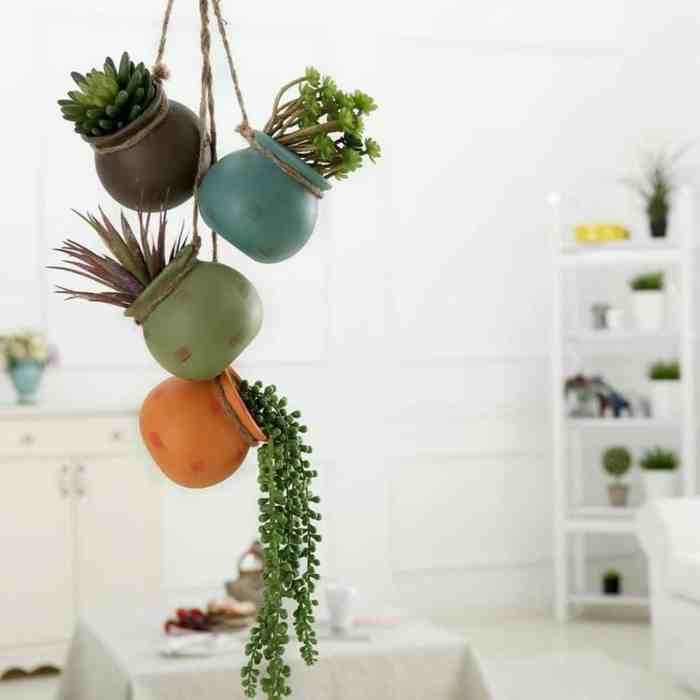
Crafting eye-catching hanging basket arrangements requires a thoughtful approach to design. By harmonizing color schemes, textures, and plant placement, you can create visually appealing displays that add a touch of nature to any indoor space.
Plant Selection
The key to a balanced hanging basket lies in the judicious selection of plants. Consider using:
- Trailing plants:These cascade over the edges of the basket, creating a lush and flowing effect. Examples include ivy, ferns, and spider plants.
- Upright plants:These provide height and structure to the arrangement. Suitable options include begonias, coleus, and African violets.
- Filler plants:These fill in the gaps between the trailing and upright plants, adding color and texture. Some popular choices include petunias, lobelia, and alyssum.
Color Schemes and Textures
The color scheme you choose can dramatically impact the overall look of your hanging basket. Consider contrasting colors for a vibrant effect or opt for monochromatic hues for a more subtle look. Experiment with different textures to add depth and interest, pairing smooth leaves with variegated or textured ones.
Best indoor hanging baskets can transform any space into a lush oasis. From trailing plants to cascading ferns, there are endless options to choose from. If you’re looking for the perfect touch to your bedroom, consider incorporating best bedroom hanging plants like ivy, pothos, or spider plants.
Not only do they add a touch of greenery, but they can also purify the air and create a calming ambiance. Whatever your preference, best indoor hanging baskets are a great way to bring the outdoors in and enhance your home decor.
Seasonal Accents and Decorative Elements
To enhance the aesthetic appeal of your hanging baskets, incorporate seasonal accents. During the holidays, add festive ornaments or ribbons. For a touch of elegance, consider using decorative elements such as moss or decorative rocks to cover the soil surface and create a polished look.
Essential Care and Maintenance for Hanging Baskets: Best Indoor Hanging Baskets
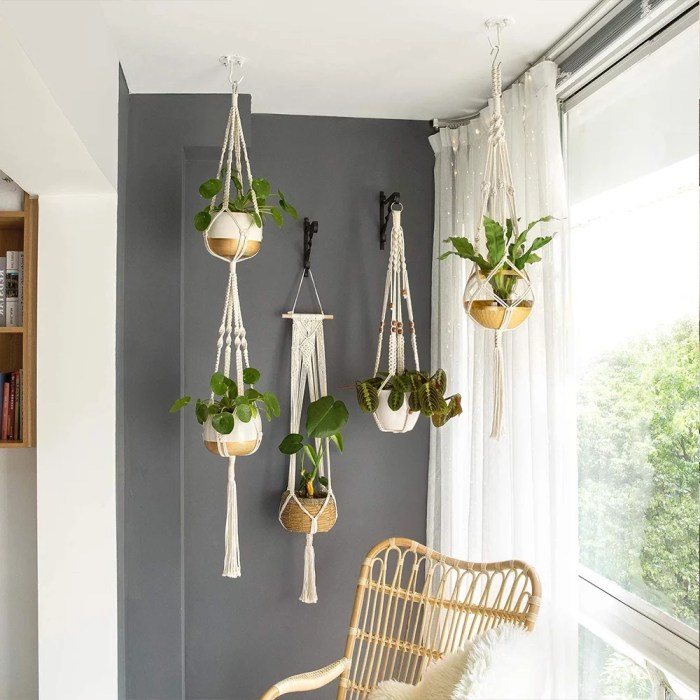
Maintaining the health and beauty of hanging baskets requires regular care and attention. Watering, fertilizing, and pruning are essential practices that contribute to their well-being. Additionally, monitoring for pests, diseases, and nutrient deficiencies is crucial to address any issues promptly.
Indoor hanging baskets are a beautiful and practical way to add greenery to your home. They can be used to display a variety of plants, from trailing vines to flowering blooms. If you’re looking for the best indoor hanging baskets, be sure to check out Plants . They have a wide selection of baskets to choose from, and their plants are always healthy and beautiful.
Watering
Hanging baskets require frequent watering due to their limited soil volume. The frequency of watering depends on factors such as plant species, temperature, humidity, and sunlight. A good rule of thumb is to water when the top inch of soil feels dry to the touch.
Use lukewarm water and water thoroughly until excess water drains out of the drainage holes.
Fertilizing
Hanging baskets benefit from regular fertilization to replenish nutrients. Use a balanced liquid fertilizer diluted to half strength every two to four weeks during the growing season. Avoid over-fertilizing, as it can lead to nutrient burn and damage to the plants.
Pruning
Pruning helps maintain the shape and size of hanging baskets and encourages new growth. Remove dead or damaged leaves and stems, and trim back overgrown shoots to promote a bushy and compact appearance. Pruning also improves air circulation and reduces the risk of pests and diseases.
When choosing the best indoor hanging baskets, consider the amount of light your space receives. If you have low light conditions, opt for plants that thrive in these conditions. For instance, the best hanging plants for low light indoors include pothos, spider plants, and ZZ plants.
These plants will add a touch of greenery and freshness to your space without requiring excessive sunlight.
Monitoring for Problems
Regularly inspect hanging baskets for signs of pests, diseases, or nutrient deficiencies. Common pests include aphids, spider mites, and mealybugs, which can be controlled with insecticidal soap or neem oil. Fungal diseases such as powdery mildew or root rot can be treated with fungicides.
Nutrient deficiencies, such as yellowing leaves, can be corrected by applying a balanced fertilizer.
Tips for Maintaining Healthy Hanging Baskets
- Use a well-draining potting mix specifically designed for hanging baskets.
- Provide ample sunlight or artificial lighting.
- Rotate hanging baskets regularly to ensure even growth.
- Clean the baskets occasionally to remove debris and prevent algae growth.
- Protect hanging baskets from extreme temperatures and drafts.
Creative Ideas for Using Indoor Hanging Baskets
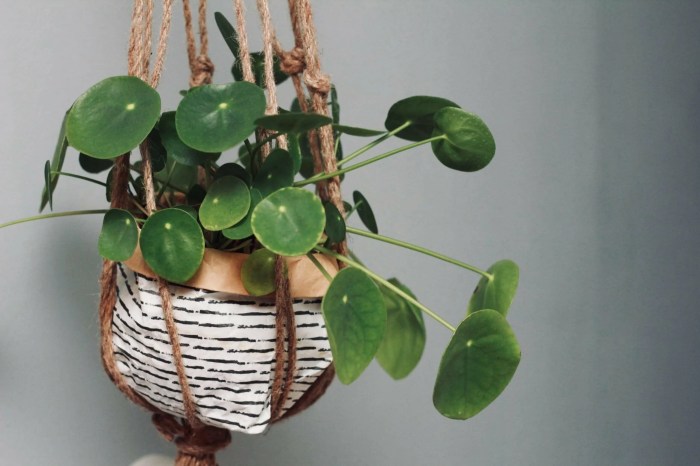
Indoor hanging baskets offer a versatile and stylish way to bring greenery into your home. Beyond their aesthetic appeal, they can also serve as functional elements, creating vertical gardens, dividing spaces, and purifying the air. This article explores innovative ways to incorporate hanging baskets into various interior design styles, from modern to rustic, highlighting their benefits and providing practical tips for creating stunning displays.
Vertical Gardens
Hanging baskets can be transformed into vertical gardens, allowing you to grow a variety of plants in a limited space. By suspending multiple baskets at different heights, you can create a lush green wall that adds depth and interest to any room.
Choose plants with trailing vines, such as ivy or philodendron, to create a cascading effect, or opt for succulents or herbs for a more structured look.
Room Dividers
Hanging baskets can be used as unique and stylish room dividers, separating different areas within a larger space. Suspend baskets from the ceiling or mount them on walls to create a semi-transparent partition that allows light to filter through while defining distinct zones.
Use large baskets filled with bushy plants or opt for smaller baskets with trailing vines to create a more delicate effect.
Decorative Focal Points
Hanging baskets can become eye-catching focal points in any room. By selecting baskets in bold colors or unique shapes and filling them with vibrant plants, you can create a stunning display that draws attention. Place them above seating areas, hang them from the ceiling in clusters, or suspend them from hooks on walls to add a touch of drama and greenery to your decor.
Air Purification and Tranquility, Best indoor hanging baskets
Indoor hanging baskets not only enhance the aesthetics of a space but also contribute to its well-being. Many plants used in hanging baskets, such as spider plants and peace lilies, are known for their air-purifying qualities. They help remove toxins from the air, improving indoor air quality and creating a healthier environment.
Additionally, the presence of greenery in a room has been shown to promote relaxation and reduce stress, contributing to a sense of tranquility and well-being.
Troubleshooting Common Challenges with Indoor Hanging Baskets
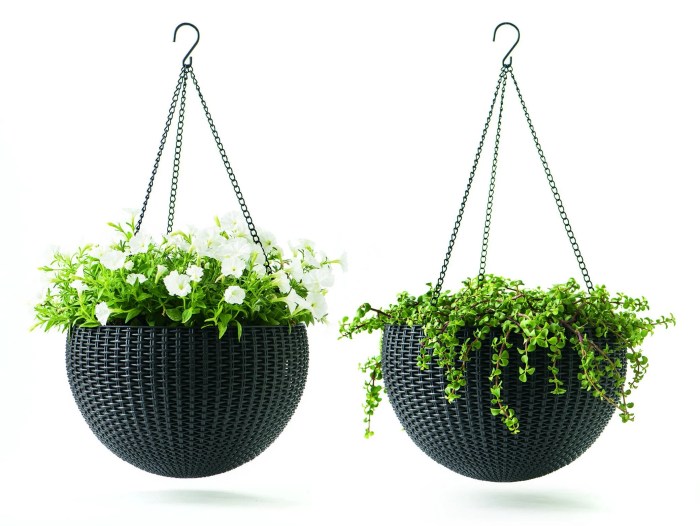
Indoor hanging baskets offer a charming and space-saving way to bring greenery into your home. However, they can present unique challenges that require prompt attention to maintain plant health and longevity.
Waterlogging and Root Rot
Overwatering is a common issue with hanging baskets. The excess water accumulates at the bottom of the pot, creating a waterlogged environment that can lead to root rot. To prevent this:
- Check the soil moisture regularly before watering.
- Use a well-draining potting mix specifically designed for hanging baskets.
- Ensure the pot has adequate drainage holes and elevate it slightly to facilitate water flow.
Inadequate Sunlight
Hanging baskets placed in areas with insufficient sunlight may exhibit stunted growth and yellowing leaves. To address this:
- Relocate the basket to a brighter location near a window or use artificial grow lights.
- Choose plant species that tolerate lower light conditions, such as ferns or ivy.
- Rotate the basket regularly to ensure even sunlight exposure.
Regular Inspection and Preventative Measures
Regular inspection of hanging baskets is crucial for early detection and prevention of problems. Check for:
- Signs of overwatering or underwatering, such as wilting or yellowing leaves.
- Pests or diseases that may require treatment.
- Loose or damaged hanging chains or hooks.
Taking preventative measures, such as using high-quality potting mix, providing adequate sunlight, and watering responsibly, can help maintain the health and beauty of your indoor hanging baskets.
Outcome Summary
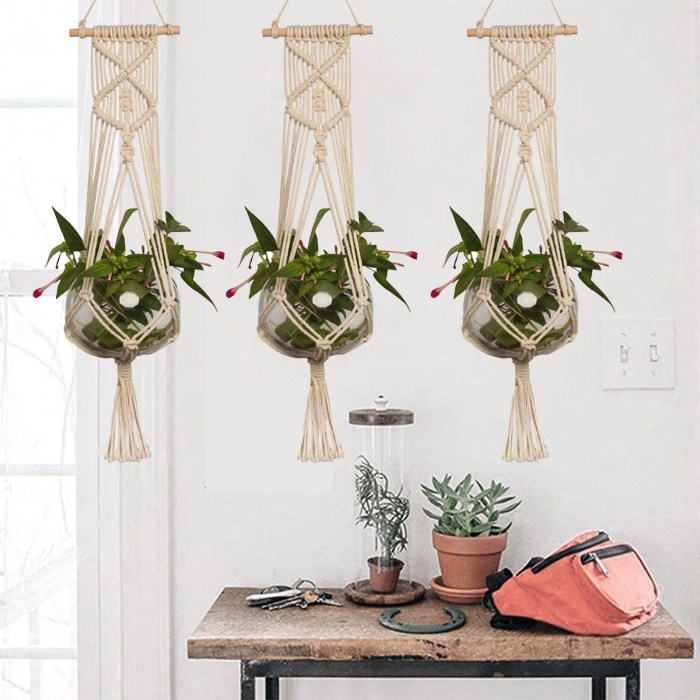
With a little care and attention, best indoor hanging baskets can be a beautiful and rewarding addition to your home. So what are you waiting for? Get started today and enjoy the many benefits of hanging baskets.
Commonly Asked Questions
What are the best plants for indoor hanging baskets?
There are many different types of plants that can be grown in indoor hanging baskets. Some of the most popular include ferns, ivy, pothos, and spider plants. These plants are all relatively easy to care for and can tolerate a wide range of light conditions.
How do I create a stunning hanging basket arrangement?
When creating a hanging basket arrangement, it’s important to consider the different types of plants you’re using and how they will look together. You’ll also want to think about the overall shape and size of the arrangement. For a balanced look, try to use a variety of plants with different textures and colors.
How do I care for indoor hanging baskets?
Indoor hanging baskets need to be watered regularly, but be careful not to overwater. You should also fertilize your plants every few months. Most hanging baskets will need to be repotted every year or two.